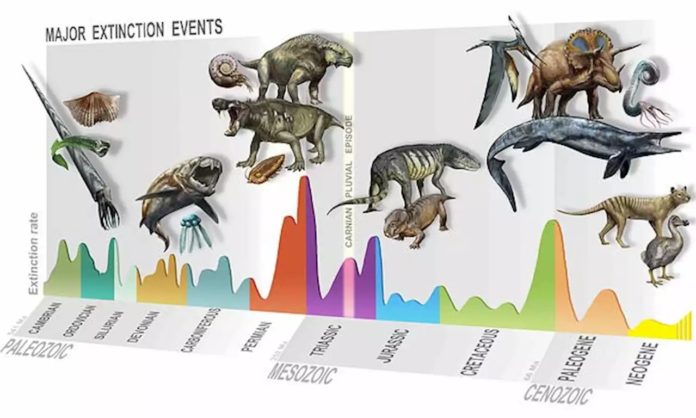The Carnian Pluvial Episode was a time of global environmental changes and possibly substantial coeval volcanism. During this stage, a significant climate change occurred, namely. The CPE occurred around 234 to 232 million years (Ma) ago. Its most marked characteristic was a remarkable enhancement of hydrological cycling marked by four episodes of increased rainfall, as indicated by diverse sedimentary and paleontological data.
A new study has identified a significant extinction of life 233 million years ago that triggered the world’s dinosaur takeover. The crisis has been called the Carnian Pluvial Episode.
For the study, scientists reviewed all the geological and palaeontological evidence and determined what had happened.
Scientists analyzed fossil data that suggests a substantial reduction in generic and species richness and 33% of marine genera’s disappearance. The cause was most likely massive volcanic eruptions in the Wrangellia Province of western Canada, where vast volumes of volcanic basalt were poured out and formed much of North America’s western coast.
Jacopo Dal Corso said, “The eruptions peaked in the Carnian. I studied the geochemical signature of the eruptions a few years ago and identified some massive effects on the atmosphere worldwide. The eruptions were so huge, they pumped vast amounts of greenhouse gases like carbon dioxide, and there were spikes of global warming.”
Professor Mike Benton said, “The new floras probably provided slim pickings for the surviving herbivorous reptiles. I had noted a floral switch and ecological catastrophe among the herbivores back in 1983 when I completed my Ph.D. We now know that dinosaurs originated some 20 million years before this event, but they remained quite rare and unimportant until the Carnian Pluvial Episode hit. It was the sudden arid conditions after the humid episode that gave dinosaurs their chance.”
Jacopo Dal Corso said, “So far, paleontologists had identified five “big” mass extinctions in the past 500 million years of the history of life. “Each of these had a profound effect on the evolution of Earth and life. We have identified another great extinction event, and it had a major role in helping to reset life on land and in the oceans, marking the origins of modern ecosystems.”
Journal Reference:
- Jacopo Dal Corso et al. Extinction and dawn of the modern world in the Carnian (Late Triassic). DOI: 10.1126/sciadv.aba0099
